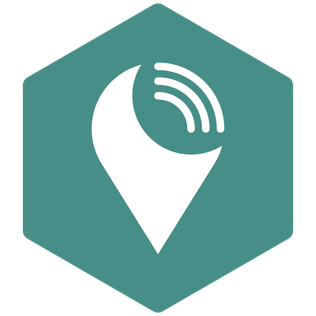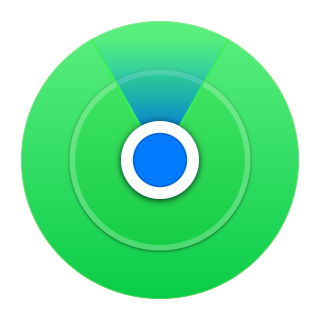
Bluetooth is a short-range wireless technology standard that is used for exchanging data between fixed and mobile devices over short distances and building personal area networks (PANs). In the most widely used mode, transmission power is limited to 2.5 milliwatts, giving it a very short range of up to 10 metres (33 ft). It employs UHF radio waves in the ISM bands, from 2.402 GHz to 2.48 GHz. It is mainly used as an alternative to wired connections to exchange files between nearby portable devices and connect cell phones and music players with wireless headphones.
Fitbit is a line of wireless-enabled wearable technology, physical fitness monitors and activity trackers such as smartwatches, pedometers and monitors for heart rate, quality of sleep, and stairs climbed as well as related software. It operated as an American consumer electronics and fitness company from 2007 to 2021.

TrackR was a commercial key finder that assisted in the tracking of lost belongings and devices. Trackr was produced by the company Phone Halo and was inspired by the founders' losing their keys on a beach during a surfing trip.

A smartwatch is a portable and wearable computer device in a form of a watch; modern smartwatches provide a local touchscreen interface for daily use, while an associated smartphone app provides management and telemetry, such as long-term biomonitoring. While early models could perform basic tasks such as calculations, digital time telling, translations, and game-playing, smartwatches released since 2015 have more general functionality closer to smartphones, including mobile apps, a mobile operating system, and WiFi/Bluetooth connectivity. Some smartwatches function as portable media players, with FM radio and playback of digital audio and video files via a Bluetooth headset. Some models, called watch phones, have mobile cellular functionality such as making telephone calls.

Tile is an American consumer electronics company which produces tracking devices that users can attach to their belongings such as keys and backpacks. A companion mobile app for Android and iOS allows users to track the devices using Bluetooth 4.0 in order to locate lost items or to view their last detected location. The first devices were delivered in 2013. In September 2015, Tile launched a newer line of hardware that includes functionality to assist users in locating smartphones, as well as other feature upgrades. In August 2017, two new versions of the Tile were launched, the Tile Sport and Tile Style. As of 2019, Tile's hardware offerings consist of the Pro, Mate, Slim, and Sticker.

The Samsung Galaxy Gear is a smartwatch produced by Samsung Electronics in the Samsung Gear family of devices. Unveiled during a Samsung Unpacked event in Berlin, Germany on September 4, 2013, the device serves as a companion for all Samsung Galaxy smartphones and tablets which runs on Android 4.3 "Jelly Bean" or newer. It was released on September 25, 2013. Originally released as an Android-based device, Samsung replaced the operating system with Tizen through the May 2014 software update.

Wear OS is a version of Google's Android operating system designed for smartwatches and other wearables. By pairing with mobile phones running Android version 6.0 "Marshmallow" or newer, or iOS version 10.0 or newer with limited support from Google's pairing application, Wear OS integrates Google Assistant technology and mobile notifications into a smartwatch form factor. Wear OS is closed-source, in contrast to the free and open-source Android.

The Huawei Watch and latest Huawei Watch 4 series are HarmonyOS-based smartwatches developed by Huawei. The Huawei Watch is the first smartwatch produced by Huawei. It was announced at the 2015 Mobile World Congress and released at IFA Berlin on September 2nd. The Huawei Watch 3 was introduced in June 2021 after the United States Department of Commerce added Huawei to its Entity List in May 2019.

Android Oreo is the eighth major release and the 15th version of the Android mobile operating system.

Google Lens is an image recognition technology developed by Google, designed to bring up relevant information related to objects it identifies using visual analysis based on a neural network. First announced during Google I/O 2017, it was first provided as a standalone app, later being integrated into Google Camera but was reportedly removed in October 2022. It has also been integrated with the Google Photos and Google Assistant app and with Bard as of 2023.

Google Pay is a mobile payment service developed by Google to power in-app, online, and in-person contactless purchases on mobile devices, enabling users to make payments with Android phones, tablets, or watches. Users can authenticate via a PIN, passcode, or biometrics such as 3D face scanning or fingerprint recognition.
The Google Fast Pair Service, or simply Fast Pair, is Google's proprietary standard for quickly pairing Bluetooth devices when they come in close proximity for the first time using Bluetooth Low Energy (BLE). It was announced in October 2017 and initially designed for connecting audio devices such as speakers, headphones and car kits with the Android operating system. In 2018, Google added support for ChromeOS devices, and in 2019, Google announced that Fast Pair connections could now be synced with other Android devices on the same Google Account, a feature which Google expanded to ChromeOS devices in December 2023. Google has partnered with Bluetooth SoC designers including Qualcomm, Airoha Technology, and BES Technic to add Fast Pair support to their SDKs. In May 2019, Qualcomm announced their Smart Headset Reference Design, Qualcomm QCC5100, QCC3024 and QCC3034 SoC series with support for Fast Pair and Google Assistant. In July 2019, Google announced True Wireless Features (TWF), Find My Device and enhanced Connected Device Details.

GrapheneOS is an Android-based, open source, privacy and security-focused mobile operating system for selected Google Pixel devices, including smartphones, tablets and foldables that is recommended by Edward Snowden.

Find My is an asset tracking service made by Apple Inc. that enables users to track the location of iOS, iPadOS, macOS, watchOS devices, AirPods, AirTags and a number of supported third-party accessories through a connected iCloud account. Users can also share their GPS locations to others with Apple devices and view the location of others who choose to share their location. Find My was released alongside iOS 13 on September 19, 2019, merging the functions of the former Find My iPhone and Find My Friends into a single app. On watchOS, Find My is separated into three different applications: Find Devices, Find People and Find Items.

AirPods Pro are wireless Bluetooth in-ear headphones designed by Apple, initially introduced on October 30, 2019. They are Apple's mid-range wireless headphones, available alongside the base-level AirPods and the highest-end AirPods Max.

AirTag is a tracking device developed by Apple. AirTag is designed to act as a key finder, which helps people find personal objects. To locate lost items, AirTags use Apple's crowdsourced Find My network, estimated in early 2021 to consist of approximately one billion devices worldwide that detect and anonymously report emitted Bluetooth signals. AirTags are compatible with any iPhone, iPad, or iPod Touch device capable of running iOS/iPadOS 14.5 or later, including iPhone 6S or later. Using the built-in U1 chip on iPhone 11 or later, users can more precisely locate items using ultra-wideband (UWB) technology. AirTag was announced on April 20, 2021, made available for pre-order on April 23, and released on April 30.

The Pixel Watch is a Wear OS smartwatch designed, developed, and marketed by Google as part of the Google Pixel product line. First previewed in May 2022 during the Google I/O keynote, it features a round dome-shaped display as well as deep integration with Fitbit, which Google acquired in 2021. Two Pixel-branded smartwatches had been in development at Google by July 2016, but were canceled ahead of their release due to hardware chief Rick Osterloh's concerns that they did not fit well with other Pixel devices. Development on a new Pixel-branded watch began shortly after Google's acquisition of Fitbit.
Google Wallet is a digital wallet platform developed by Google. It is available for the Android, Wear OS, and Fitbit OS operating systems, and was announced on May 11, 2022, at the 2022 Google I/O keynote. It began rolling out on Android smartphones on July 18, 2022.














